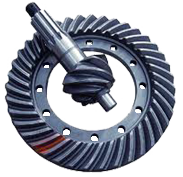Bevel Gears

Where two axles cross at point and engage by means of a pair of conical gears, the gears themselves are referred to as bevel gears. These gears enable a change in the axes of rotation of the respective shafts, commonly 90°.
A set of four bevel gears in a square make a differential gear, which can transmit power to two axles spinning at different speeds, such as those on a cornering automobile.
There are four basic types of bevel gears :
Straight bevel gears: These gears have a conical pitch surface and straight teeth tapering towards an apex
Zero bevel gears: This is similar to a bevel gear except the teeth are curved. In essence, Zero Bevel Gears are Spiral Bevel Gears with a spiral angle of zero Spiral bevel gears: The teeth are curved teeth at an angle allowing too contact to be gradual and smooth
Hypoid bevel gears: These gears are similar to spiral bevel except that the pitch surfaces are hyperboloids rather than cones. Pinion can be offset above or below gear center, thus allowing larger pinion diameter, and longer longer life and smoother mesh, with additional ratios e.g., 6:1, 8:1, 10:1
|

